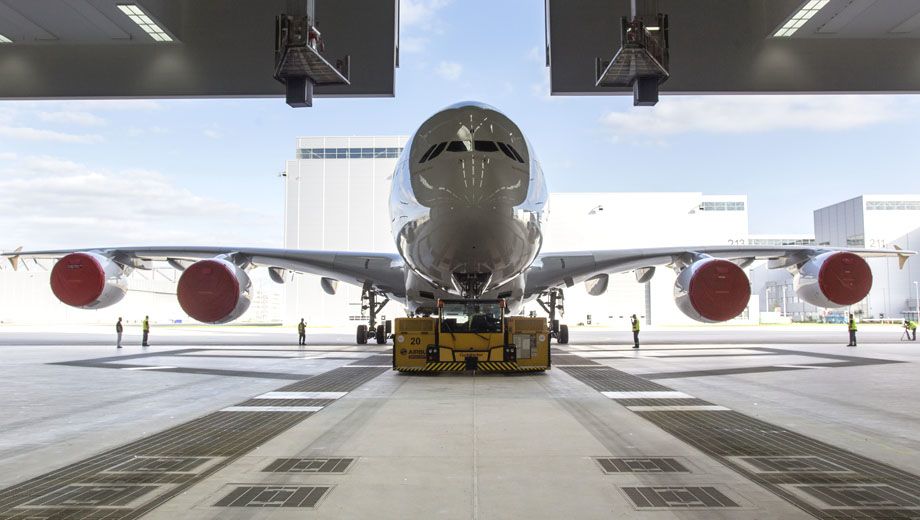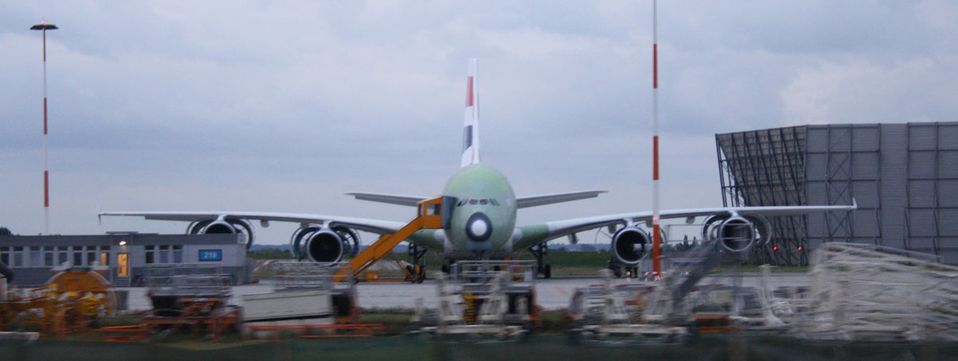Have you ever wondered how the monstrous Airbus A380 gets its wings before arriving at your boarding gate just like any other jet?
The process actually starts in thirty different countries, with no less than 1,500 companies manufacturing roughly four million individual parts that will later come together to form the world's largest passenger aircraft.
That all happens at the Airbus factories in Toulouse (France) and here in Germany, where Australian Business Traveller toured Hamburg's Finkenwerder Airport (XFW, if you're into airport codes) and the company's A380 Major Component Assembly facility.
Situated in Hangar 260, the first thing you notice is its sheer size.
This is no ordinary plane shed, clocking in at 228 metres long and 120 metres wide – in which you could fit 104 full-sized tennis courts with room to spare!
Here, the front and rear fuselage sections are assembled from parts produced elsewhere...
... and can be moved around the hangar with ease using a ceiling-mounted crane system.
Factory workers, of which there are 645 in this hangar alone, can reach any section of an aircraft-to-be through a network of specially-designed jigs:
Rather than a one-size-fits-all approach, aircraft shells are moved from one area of the hangar to the next as construction progresses – again with jigs to support the task at hand:
Once the A380 starts to take shape, mechanical and electrical systems make their first appearance.
That includes everything from water supply and air conditioning right through to the aircraft doors, windows and floor panels:
Signs are displayed next to each assembly area to indicate the aircraft's Manufacturer Serial Number (MSN), the section currently being produced and the purchase customer.
In this case, we're looking at 'section 18' of what will be the 186th A380 ordered from Airbus, destined for Emirates:
MSN186 will eventually be registered as A6-EOL and will enter service as Emirates' 64th superjumbo.
The A380 components assembled here in Hamburg are shipped to the final assembly line in Toulouse on a specially-built roll-on, roll-off ship.
That's where the giant bird truly gets its wings – and its tail, which is pre-painted before being connected to the fuselage.
After attaching the engines and doing a final test, aircraft are then flown back to Hamburg for a proper paint job.
That's done in the 'Lackierhalle', which translates literally as the "paint shop". We're allowed inside for a sneak peek, but as the full process is commercially sensitive and normally done behind closed doors, cameras are left behind.
Superjumbos emerge between 10 and 15 days later, covered in approximately 650kg of paint and looking much as you'd see at any airport terminal.
All that's left is to fit out the A380's double-deck interior – including the passenger seats, cabin walls and overhead lockers – before the aircraft is ready for delivery to the purchasing airline.
Once that happens, it's like any other bird in the sky: ready to take paying passengers on the holiday of a lifetime, on their next business trip or even just across the ditch to Auckland for a weekend away.
This two-minute video captures the entire process from start to finish – produced by Emirates during contruction of the airline's 50th superjumbo:
Also read: Photos: the Airbus A380's secret hangout zone for cabin crew
Chris Chamberlin was a guest of Airbus.
Follow Australian Business Traveller on Twitter: we're @AusBT












Qantas - Qantas Frequent Flyer
18 May 2011
Total posts 233
Image 6 is the read pressure bulk head.
It is a giant dome that is at the back of the air craft behind the toilets, under the tail.
QFF Gold QC gold
26 Nov 2012
Total posts 56
I like the smiley face in image 4
Hi Guest, join in the discussion on Photos: behind the scenes at the Airbus A380 factory